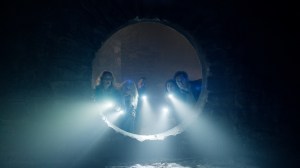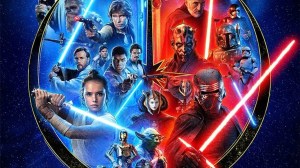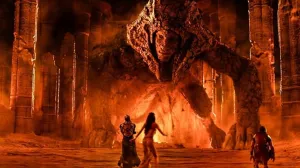Keep superhero comics weird. That must be the slogan of Doom Patrol. Throughout the series run under the Young Animal imprint, it has embraced the strangest elements of the team’s past while developing an even odder future. Everything from Casey Brinke’s comic book birth to the reintroduction of Crazy Jane have been building to “Milk Wars” and a direct commentary on superhero comics. The first installment in this crossover features the JLA—the best possible point of comparison between these two teams. The results are extraordinary.
Videos by ComicBook.com
ACO’s first work on the Young Animal line serves to make this one-shot stand out even from the beautifully bizarre work of Nick Derington on Doom Patrol. A handful of pages framed with standard grids dot the issue, but any opportunity to reinterpret the reading experience is seized. Some of these efforts are cute; the introduction of Milkman Man is framed entirely within milk bottles. Others are devastating; a family’s murder is shown only in close ups of the least gruesome elements, focusing on the eyes or exteriors of a house, while sound effects tell the tale. This level of versatility makes the comic incredibly engaging, discovering each page becomes its own delight. More importantly, it creates a foundation for the dramatic tonal shifts taken through the comic. With each page existing as its own piece and part of a whole, it becomes easier to accept quick jumps from horror to comedy to conspiracy.

The ability to pack so much information into any given page makes the scope of JLA/Doom Patrol manageable. There’s a baker’s dozen of leading characters stacked into 40 pages. They each get their own moments too as even small panels highlight powers and personality with unique sound effects and design. Nobody is entirely forgotten and the result is a single issue that reads more like an OGN (original graphic novel). Even a four-page spread that reads like a poster functions as it captures the chaos of a moment. There is a static quality to the enormous menagerie that realizes this frozen split second of the classic superhero team showdown.
This is the moment in which JLA/Doom Patrol really begins to tackle the careful balance of its crossover. Beyond the plot of RetConn attempting to homogenize and sell the Earth, there is a metatextual struggle about what superhero comics should or can be. The JLA represents a more wholesome norm while the Doom Patrol is the far edges of the genre. There is a balance provided between the two, but a question of engagement and interest remains. One of the most interesting elements on the page is an obvious point of agreement between the two: their shared diversity. Both Orlando’s JLA and Way’s Doom Patrol represent a diverse cross-section of experiences touching on race, gender, disability, and orientation. Showing them together and functioning in such exciting action sequences makes a point about who superhero comics are for far better than any monologue could.

For all the joy there is in seeing these teams unite, “Milk Wars” remains a horror story at its heart. The very existence of Milkman Man reads like apostasy, rejecting everything superhero comics can be for their most bland and cruel elements wrapped up in the whitest version of Superman imaginable. His origin only makes his being more tragic. The threat on these pages—one superhero fans know will be resolved by February’s end—still feels real because it speaks to a larger existential fear of culture. Everything from page layouts to the briefest of character moments speak to a better way forward, and heroism rises from the notion of being different. “Milk Wars” showcases a unique and strange form of bravery, and makes superhero comics feel important again.
Grade: A
Published by DC Comic
Publication Date: January 31, 2018
Written by Steve Orlando and Gerard Way
Art by ACO with Hugo Petrus
Colors by Tamra Bonvillain and Marissa Louise








